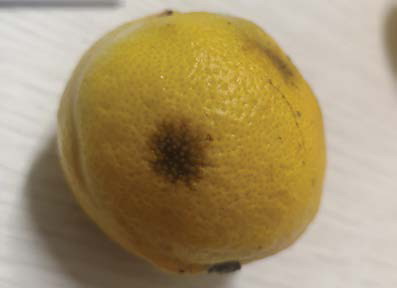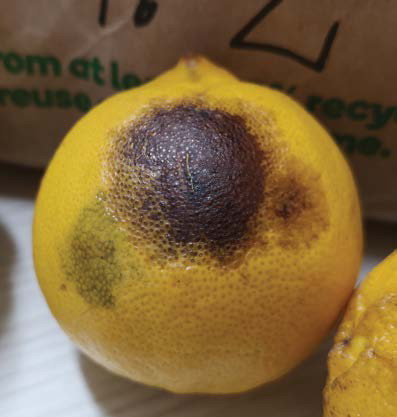
WA lemons
make the grade for export
A major concern for successful export market performance, is chilling injury.
THE export protocol for lemons to premium markets requires fruit to be subjected to a cold treatment of 2°C for 16 days.

BY ELBE COETSEE INDUSTRY DEVELOPMENT OFFICER, WA CITRUS
Increased plantings of seedless lemons in Western Australia are leading to higher volumes of lemons in the markets. To maintain profitability, one option is for growers to expand into export markets with fruit of high quality.
Factors affecting fruit quality in the market include the conditions at harvest, postharvest practices, as well as cold chain management in-transit and at the market destination.
The export protocol for lemons to premium markets requires fruit to be subjected to a cold treatment of 2°C for 16 days. This is normally done in transit on the container ship. With this temperature, susceptibility of lemons to cold temperatures and current container shortages and shipping delays, one major concern for successful export market performance, is chilling injury in lemons.
Following a trial done in early 2020 on looking for chilling injury in summer lemons, an investigation targeting winter lemons from six orchards in WA was done this year between July and September.
Lemons were collected from six growers, based in three growing regions. The fruit was stored at 2°C for 16 days as per the export protocol and then assessed (see Figure 1).

FIGURE 1. AVERAGE PERCENTAGE FRUIT WITH NO VISIBLE CHILLING INJURY AND OLEOCELLOSIS, AFTER BEING STORED AT 2°C, FOR SIX GROWERS.
Fruit was also stored for a longer period of 31 days to investigate the effect of extended exposure to low temperatures that may occur during shipping delays. After removing the fruit from storage for both periods, fruit were kept for a further week at 20°C to simulate shelf-life.
Fruit was assessed for evidence of chilling injury and other quality disorders that appear postharvest such as oleocellosis and fungal infections.
Chilling injury happens after prolonged exposure to low temperatures. Black sunken spots appear where the peel collapse and darken to form pits. These pits are not targeted to oil glands.
Oleocellosis, or oil spotting, happens when oil glands in the rind gets damaged, releasing phytotoxic rind oil on the surrounding tissue. Over time, the damaged tissue discolours turning from green to brown and eventually black.



SIGNS of chilling injury — black sunken spots appear where the peel collapse and darken to form pits.



STAGES of oleocellosis — skin started to discolour to a light green and turning black in severe cases.
Best practice to reduce oleocellosis:
• Avoid moisture when picking — dew, rain, or irrigation
• Handle fruit with care
• Wait 24 hours after picking, before moving bins
• Degreen at 90–96% humidity to reduce darkening of oil spots
• When not degreening, store fruit at high humidity without ethylene
Lemons are most prone to rupturing oil glands when the fruit on the tree is turgid, especially in cool temperatures, after rain, or when it still has dew on the skin. The glands can rupture from rough handling during picking. The effect of the damaged oil glands is often not visible at picking, but discolouring develops over time and usually appears once fruit has left the farm.
Preliminary results from our study indicated an average of 76% of fruit had no visible signs of chilling injury or oleocellosis after 16 days storage. This was from a range of 30 to 100% for the six different growers. At this assessment time, fruit from two growers were not affected by oleocellosis.
Winter-harvested lemons in WA have the potential to reach premium protocol export markets.
After a shelf-life period, on this fruit oleocellosis became more visible, reducing the average by 9% to 67%. No chilling injury was observed.
After storing fruit at 2°C for the longer period of 31 days, an average of 69% fruit had no visible chilling injury or oleocellosis. After a week at shelf-life conditions, the average reduced by 8% to an average of 61%. This means the potential longer shipping time can result in a further 7% loss due to chilling injury or oleocellosis.
For this extended storage, all growers were affected by oleocellosis to varying degrees and three out of six growers were affected by chilling injury.
Results to date show winter-harvested lemons in WA have the potential to reach premium protocol export markets, without compromising their quality, giving growers the confidence to explore diversifying their markets.
The next steps are to complete analysis for fungal infection that appear postharvest, and then work with growers and the supply chain to improve the industry average performance in quality winter lemons.
This work is being done with support from John Golding, NSW DPI.
MORE INFORMATION
Contact Elbé Coetsee at: elbe.coetsee@dpird.wa.gov.au